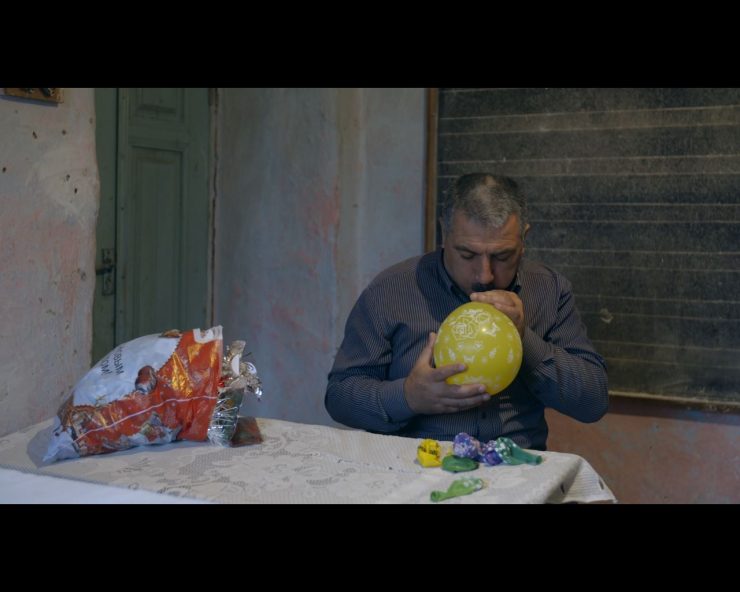“Bilasuvar”: Walking on the trail

The common problem and the primary challenge faced by Azerbaijani cinema is its heavy reliance on local themes and ideas that have limited appeal outside the country. With a few exceptions, Azerbaijani filmmakers have continuously sought to connect with the global cinema scene by incorporating a range of ideas rooted in their local context. Sometimes, this local context is presented through the lens of “oriental mysticism,” as seen in films like “Divine Creature,” “Bat,” “40th Door” and “In Between Dying.” At Another Times, the focus shifts to the Karabakh problem, with movies such as “Scream,” “The Yellow Bride,” “Lie,” “Hostage,” and “Man of the Third Day” delving into this sensitive issue. Additionally, Azerbaijani cinema has explored the challenges arising from the post-Soviet era and the perceived “moral degradation.” Films like “I have sprinkled water onto the Streets,” “Death Queue,” “Goodbye, Southern City,” and “Pomegranate Orchard” have attempted to address these concerns and garner international attention. As a result, Azerbaijani filmmakers` view cinema as a medium to reflect a “great idea in cinema,” and their primary target audience for this “great idea” is “Foreigners,” especially those in the West. In essence, cinema in Azerbaijan serves as a vehicle to display “our great idea” and make it visible to the “Great Other” beyond our borders. Hence, in Azerbaijani cinema, the central theme revolves around a child’s endeavor to conform to the perceptions of the “Big other,” whose validation is essential for his existence. This intricate relationship with the “Big other” often mirrors the dynamics between a son and his father. Notably, many Azerbaijani films accentuate the complexities of father-son relations, explore the concept of “crises of masculinity,” and portray the struggles of boys who find it challenging to transition into adulthood. However, delving deeper into this subject will be the topic for another post. In the context of Azerbaijani cinema, it is essential to highlight the prevailing trend of moving from top to bottom, where films often progress from the conception of an idea to its concrete representation.

However, as emphasized by Siegfried Krakauer, a pioneering figure in cinema theory, the true essence of a good film lies in its ability to operate on the surface of physical reality. This means reflecting a particular idea, spirituality, or belief onto seemingly formless objects and situations, without imposing the idea from above. Walter Benjamin, in a fragment of his essay “One-way Street,” intriguingly compares the perspectives of viewing a road from above, such as from an airplane, with that of someone experiencing the road on the ground. From the vantage point of an airplane, the observer beholds a vast landscape, an unending plain, and the road appears to conform to and follow the laws of this broader panorama. However, as Benjamin astutely points out, only the person who has traversed that road on foot truly comprehends the intrinsic dictates of the road itself.
The observer in the airplane becomes engrossed in a world of dreams and contemplation, experiencing the sensation of “free flight.” On the other hand, the individual walking the path unearths new distances, fresh angles of vision, unexpected openings, and captivating scenes from the seemingly plain landscape that appeared from above. In this regard, “Bilasuvar” stands out as one of the exceptional films that successfully overturns the prevalent cinematographic style seen in mainstream Azerbaijani cinema. Unlike the conventional approach of reflecting ideas onto objects from above, “Bilasuvar” skillfully constructs its own cinematic universe by firmly adhering to the reality and surface of the objects it portrays. It does not merely look down on the road but traverses a continuous path, immersing itself in the tangible world. It is perhaps the only exception so far made in this sense.
Five is better than one
When Andy Warhol arranged thirty reproductions of the Mona Lisa, an iconic and historically significant artwork (although not always seen as such), he humorously titled it “Thirty is better than one” in 1964. In doing so, Warhol followed the avant-garde tradition, continuing the performance that challenged the originality and mythical reverence of the original artwork. However, he took it a step further by fully commodifying the piece and situating it within the realm of pop art. Warhol boldly stated that “a work of art is what you see as any commodity; there is no sublime meaning behind it.” This declaration marked the end of a certain type of art once again, as he sought to demonstrate that modernist art, with its ambition to triumph over life, had actually been defeated by life itself. Warhol’s approach celebrated the victory of life (represented by capitalism) over art, and he did not shy away from expressing his contentment with this outcome.
In the era when Warhol celebrated the rise of pop art, emphasizing the dominance of the visible surface of objects and commodities over the mythical aura, cinema emerged as a compelling counter-argument. Modernist cinema shattered the mythical aura and the exclusivity associated with traditional art, offering the intriguing possibility of constructing a new artistic aura. Thirty was better than one, but art precisely cinema had the opportunity to create a new aura by augment. It was in 1936 that Walter Benjamin first highlighted this potential of cinema in his essay “The Work of Art in the Age of Mechanical Reproduction.” According to Benjamin, advancements in technology eradicated the uniqueness and original aura of art, but in turn, bestowed upon it a new, more “democratic” aura, with photography and cinema being prime examples of this transformation. Indeed, Benjamin’s early warning became especially evident in post-1960s modernist cinema. Unlike traditional art forms that emphasized “belonging” and “originality,” cinema and other image forms adopted a different approach—one that embraced the idea of multiplication, detachment from singular ownership, and the ability to be comprehended through its diverse manifestations. In this context, objects within the cinematic realm held more significance than mere commodities, as they came to represent profound truths. While the Renaissance era, particularly in classical fine art, established aura and depth through the discovery of perspective and the stable viewpoint of the observer, modernist art took a contrasting path. It found its essence in the multiplicity of perspectives, constant displacement, and the impossibility of fixing a single view. This unique quality was not solely derived from the reproduction or copying of the film itself; rather, it emerged from the intricate interaction of multiple images, objects, narratives, and stories within the films.

Indeed, the nature of film viewing precludes a one-to-one relationship with the work, as it can be easily copied and shared among others. Whether people have watched, are watching, or will watch the film, it fosters a social experience, inherently entwined with the perspectives of others. Consequently, the act of watching and comprehending a film is inseparable from the awareness of others’ gaze. It is virtually impossible to engage with a film without pondering what others might have seen, are seeing, or will see in the very same film. In Jacques Lacan’s concept of the “spectator-object,” he describes it as a state where a spectator finds themselves in a unique position of observing spectators who, in turn, is also observing them. This creates a fascinating entanglement of gazes, where the dynamics of mutual observation become intricately intertwined.
On the flip side, there exists a dynamic interplay of perspectives within which our outlook becomes entwined with the surface, screen, and inner layers of the film. This encompasses not only the visuals and objects that arrest our attention and lure us in, but also the unshown dreams and fantasies that the camera leaves beyond its frame. Yet, this act of drawing us into the surface also wields the film’s ability to estrange us from our very selves. The price we paid for attaining a sense of corporeal unity, an identification with the imagery, was the emergence of fault lines within our sense of self. To put it more straightforwardly, the revelation of our bodily completeness inadvertently paved the way for a schism in our identity to transform into something alternative—a different possibility. This transformation might involve the suppression of our primal urges and the acceptance of certain sacrifices. Modernist cinema encapsulated the exploration of this “new reality,” functioning within these two realms.
On this context, the film “Bilasuvar” adeptly juxtaposes images, movements, and objects—simultaneously drawing them closer and pushing them apart. It fractures our sense of coherence through their disjointed interaction, establishing a connection between the viewer and the film riddled with intervening barriers and delays. Often, the camera assumes the role of both a distant observer and a concealed participant, moving away from the subject matter. This cinematic work finds itself aligned with the current of modernist cinema, serving as a poignant reminder that “this is a film.” Through this reminder, it manages to estrange us from the film’s narrative while subsequently guiding us back to our own reality.
“Bilasuvar” transcends the confines of a traditional tale centered around singular images, depictions, or objects. Instead, it takes on the form of a contemporary tapestry, interwoven with five distinct narratives that exist in a state of indivisible coexistence. This intricately woven structure thrives within a realm of fragmented communication, employing divisive objects and images that thwart the seamless integration of these narratives.
The essence of “Bilasuvar” lies in its proposition of a “dynamic perspective.” Rather than seeking to mirror reality, the film stands as a testament to the very impossibility of such reflection. It exemplifies the essence of the modern world, characterized by fragmentation, and underscores how this fractured reality can only be comprehended through the art of montage. The gaps that persist between these fragments defy seamless amalgamation into a complete whole, yet coexist alongside these very fragments, bestowing upon them a unique value.
The film masterfully operates within the realms of division and emptiness, effectively navigating both time and space. In the following parts, I will try to explore this time and place that the film “Bilasuvar” is intricately founded.
I Entrusted My Secret to Time
The initial golden rule stressed in traditional screenwriting classes highlights the paramount significance of timing within the opening 5-6 minutes of a film. During these crucial moments, every single minute, every fleeting instance, bears a weight far greater than the cumulative use of time throughout the remainder of the movie. This is primarily because the task of re-engaging an audience that fails to establish a connection with the film within this brief timeframe is an exceedingly challenging feat. In this context, “Bilasuvar” stands out as a noteworthy exemplar of effectively employing time from the very outset to captivate and retain the audience. Indeed, “Bilasuvar” not only succeeds in crafting an engaging initial story within the first 8 minutes but also skillfully intertwines temporal breadcrumbs that foreshadow the entirety of the subsequent film. Furthermore, the movie adeptly establishes the ambiance and intricate nuances that permeate the entire narrative right from its opening scenes. For instance, in “Don’t Look for Me,” the story concludes with meticulously timed descriptions of objects and their enigmatic vanishing, weaving an air of intrigue that lingers as a pervasive undercurrent throughout the film. This narrative technique allows us to remain deeply immersed in the film, casting a subtle yet captivating shadow over each segment of the movie.
However, time doesn’t merely confine itself to the opening narrative; it intertwines with us in an intricate spiral throughout the entirety of the film. We find ourselves navigating this winding temporal path, distinct from the linear progression common in other films. Unlike the linear sequence where each event stems from the preceding one, the spiral time we encounter in the realm of modernist cinema defies the conventional cause-and-effect relationship between situations. Within this captivating spiral of time, the story-situations unfold in a manner devoid of boundaries. The narrative, instead of adhering to a predefined structure, has the potential to extend infinitely, allowing for a captivating and limitless exploration of the cinematic landscape. In this realm of spiral time, the film’s essence becomes an enigmatic dance of moments, inviting the audience to embark on an uncharted journey through the intricate corridors of storytelling. Within the realm of spiral narrative, resolutions to predicaments are transient, akin to fleeting glimpses of “comprehensive and concluded wisdom,” yet they bear no sway over the commencement of the subsequent tale. Following each episode, an infinite array of permutations on the identical theme can unfurl. At the film’s premiere, an attendee hailing from Bilasuvar remarked on the rapid culmination of the story, envisioning an indefinite expansion of the cinematic experience. Herein lies the sole method to curtail the ceaseless stimulation—to disrupt the spiral, to unexpectedly shatter the circuit that perpetuates the cycle.

Just as there are no linear time transitions between stories in “Bilasuvar”, the situations that follow each other within each story, the sequence of cause and effect is often broken, allowing us to feel each episode separately.
For example, in the story “Come, Let’s Go to My Place”, the lively and emotional environment between two friends (acquaintances) in a restaurant is torn apart by the “cigarette” suddenly intervening and the different time and reality of the two characters. The difference between the time inside the room and the time outside makes us feel two different times at the same time: it’s time to go outside, it’s time to stay inside.
The ongoing dialogue, seemingly capable of stretching into eternity, offering glimpses into concealed secrets, smoldering resentments, envious undercurrents, and eventual reconciliations, encounters an abrupt disruption in the form of a solitary object – a cigarette. This unexpected intrusion serves as a catalyst, instantly propelling us into two divergent temporal planes through its sudden maneuver, effectively cleaving the continuum of time itself.
In the story “Don’t worry, Mrs. Gunel,” Mrs. Gunel’s reminder at the table to “go on time and come back on time” for the wedding, and Gunel’s own urgency when she stresses “we’re late” in the yard, sets the initial tone. However, the narrative takes an unexpected turn as an additional element comes into play, altering and expanding the previously narrow time frame. This shift in the storyline brings about a transformation in the story’s ambiance. Specifically, the car that was meant to ensure their timely arrival at the wedding becomes uncooperative, introducing an extraneous obstacle.
While the film boasts a plethora of time-related intricacies, what truly holds significance is the seamless integration of this spiraling temporal motif into the film’s overarching narrative. Beginning with the initial story, wherein we embark on a journey from the outer fringes of civilization inhabited by the “socially useless” (unemployed) and those seemingly “discarded from society” – individuals deemed “unnecessary” by societal norms – we are led to believe that we are traversing through time. It’s as though we are progressing towards the very heart of civilization. The main story, which begins at the edge of civilization, seems to lead us in the direction of the “ideal of life” along the lines of school – theater – show business (fame). However, as this temporal journey ostensibly propels us toward the societal “center of the world,” a paradox emerges wherein our trajectory leads us further ahead only to strand us once more at the very edge of civilization. In this intricate twist, the illusion of linear time intricately tied to life itself is shattered. Instead, what surfaces is a poignant reminder of the overwhelming abyss of emptiness that saturates the modern human experience. For a more comprehensive grasp of this profound revelation, one must closely examine the film’s spatial dimensions.
Emptiness as Space, Nothingness as Existence
Film theorists have often held the belief that the existential void portrayed within the image harmonizes with the depiction of expansive empty spaces, and this misconception is primarily traced back to Antonioni. According to this view, Antonioni masterfully employed blank landscapes as a means to articulate the soul of the character (as exemplified by S. Chatman’s term “landscape as a state of mind” in reference to Antonioni’s cinema). Subsequently, numerous directors who followed in his footsteps adopted this practice of utilizing the landscape as a canvas to mirror the mental state of the character. It’s underlined that the “images within the landscape,” captured through static medium shots, lingering long shots, or occasionally shifted medium shots, seamlessly integrate into the very fabric of the surroundings. Both the “objects within the landscape” and the atmospheric qualities of the environment are said to convey the same emotional significance as the actions and demeanor of the image. This perspective suggests that in certain films, other objects serve primarily as symbolic representations of inner emotions. A recent and typical example of this “bait” in Azerbaijani cinema can be observed in the film “The Island Within.” However, Antonioni’s films tend to convey the opposite idea – the scenery remains disconnected from the characters’ psychological experiences. Throughout many of Antonioni’s works, this disconnect is emphasized, often highlighting the stark contrast between the vacant nature of the imagery and the vibrancy of the landscape. This means that even though the scenes might be throng or emotionally charged, the emotional resonance is diminished due to their detachment from the characters’ lives. This creates a palpable sense of emptiness, isolation from the surroundings, and a lack of genuine communication despite the apparent celebratory or moving moments.
In the film “Bilasuvar,” the space itself isn’t merely an empty void; rather, it serves as a backdrop that accentuates the void within the relationships it interlaces with the characters. Right from the outset, this juxtaposition is evident in the very titles of the stories. As the film commences with the phrase “Don’t look for me,” and traverses through quiet, vacant expanses, a sense of absence is immediately established. The young man, on the brink of embarking on military service, finds that his impending absence elicits not expressions of dismay from those around him, but instead inquiries such as “Why hasn’t he left yet?” and “When will he depart?” The voice messages he dispatches to the girl he loves (and to the audience), conveying the notion of his imminent disappearance with the words “you won’t see me again,” hang unanswered. In essence, this young individual’s “existence” appears to be defined not by his presence, but by his absence. Throughout this journey, the various settings serve as catalysts for the young man’s confrontation with the concept of nothingness – be it the frayed yet vibrant eatery, the secure domestic ambiance resonating with the television’s animated buzz, the intense emotions aroused by the gambling table, or the ultimate confrontation with nature.
Similarly, other spatial situations complement other characters in the film in various ways. Take, for instance, the scenario depicted in “You Are Nothing to Me” (yet another exploration of nothingness). Here, the theater director, returning home in the wake of realizing his inauspicious romantic involvement with the actress, undergoes a symbolic emasculation, mirrored by the mellifluous tones of a female singer emanating from the television. This incapacity for intimate connection, the initial rupture, unfurls as a conduit for the emergence of “domestic female power” (a concept rooted in psychoanalysis, where the reality of unattainable connection finds embodiment in its most elemental form, often associated with “female pleasure”). Put simply, this cinematic paradigm shift in sexuality unveils the chasm concealed behind both “male sexual potency” and “male dominion,” masterfully accentuated through the prism of spatial interplay.
The finale of the last story, “Sometimes Disappears,” (even more nothingness) holds a pivotal insight. While the film initially embarks from a place of nothingness towards the center, a remarkable shift occurs as we encounter nothingness once again in the very heart of this center. Delving deeper into the genesis of this center is enlightening. The narrative unfolds with a director’s arrival in Bilasuvar to shoot a music video, yet an intriguing twist emerges – his motives extend beyond monetary negotiations or practical preparations, such as carrying a spare battery. Instead, he arrives with the intention of not just departing, but of immersing himself in the void, unraveling his own sense of nothingness.
The fishing shack, where he seeks refuge, serves as a significant backdrop – positioned even farther from the film’s “center” where it all commenced. This remote abode resides at the very periphery, on the edge of edges. While the director may initially appear disheartened by his inability to secure a loan, a transformative moment occurs as he gazes out of the shack’s window into the nocturnal expanse. In a subtle yet poignant manner, his yearning finds solace, rewarded with the simple comfort of a bed. Within the refuge of this humble hut, amidst the daunting darkness of the desert, he unearths a newfound ease. The bed, earned through his earnest efforts, becomes emblematic of a unique form of liberation. This liberation is rooted in the aftermath of his sincere exertions, casting aside the external world and its concerns. The same nothingness that once birthed anxiety at the film’s outset has metamorphosed into a profound sense of freedom as the story concludes. Evidently, anxiety and freedom, seemingly disparate, reveal themselves to be interconnected facets of the same enigmatic coin.
The true essence lies predominantly within this very location – entwined intricately with the cinematic contribution in shaping the dichotomous framework of outskirts (the province) versus nucleus (the center), emptiness versus liberation.
The choice of the Bilasuvar region for the film doesn’t depict a remote, culturally detached place far removed from our familiarity. On the contrary, Bilasuvar is a province situated close to the capital city of Baku, nestled at the crossroads of several semi-urban areas, and it shares borders with the Central Aran region. The frequent inclusion of scenes showcasing the central area of Bilasuvar in the film, complete with bustling car horns, lively street sounds, and illuminated buildings, effectively conveys the concept of interconnectedness not with some far-off location, but with proximity, with a sense of “us”. Bilasuvar isn’t a distant province; rather, it is a neighboring province, easily accessible and relatable to our own surroundings.
To embark on a journey of understanding the “province” and what lies beyond our immediate surroundings, it is prudent to commence right here – from our neighboring province, our very own “home” province. This nearby region, intimately familiar to us all, possesses the tendency to impede our progress and thwart positive opportunities, consistently deferring our endeavors and seemingly pinpointing flaws at every turn. The unique path towards contemplating emptiness and liberation in unison unravels as we ponder upon this familiar and intimate province – one that is an extension of ourselves.
Toghrul Abbasov
